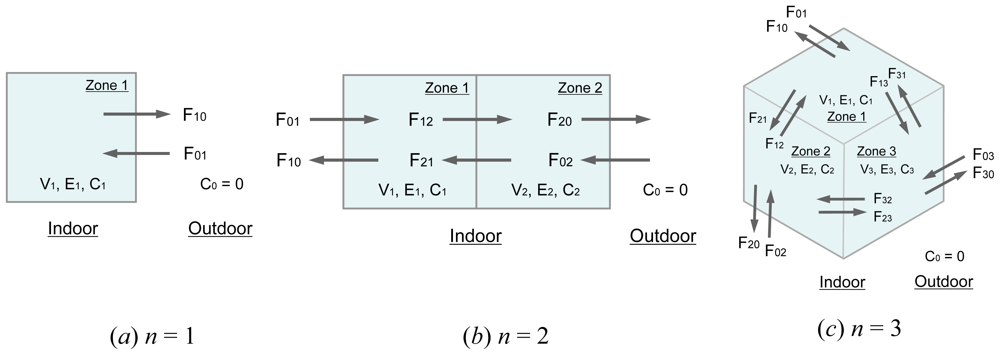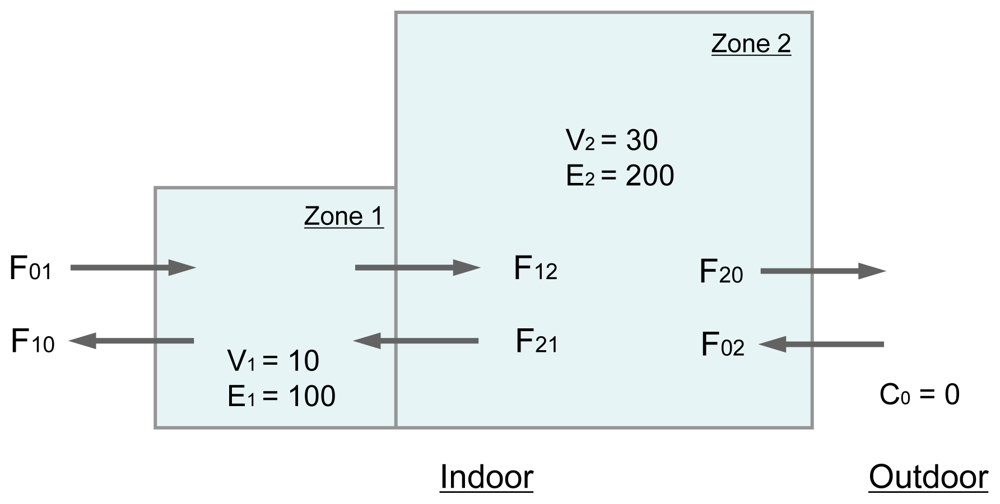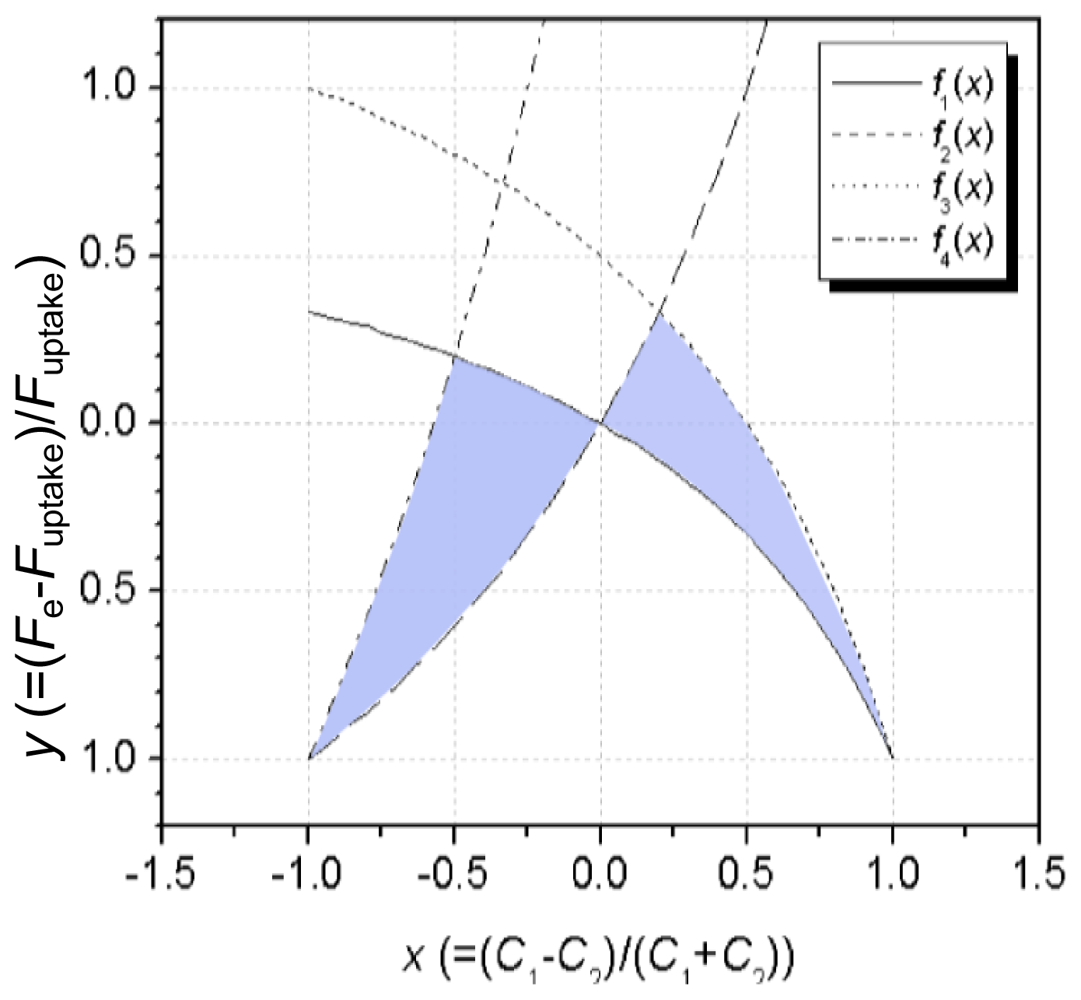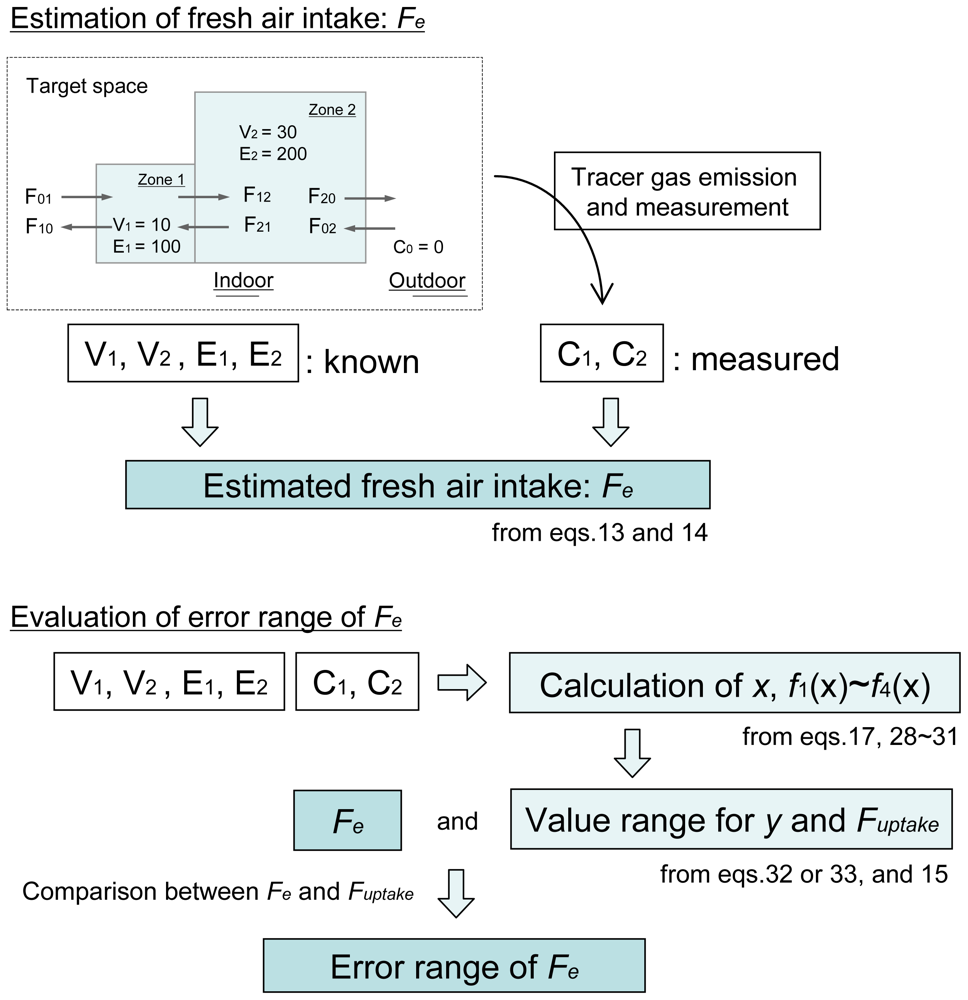Estimation of Uncertainty in Tracer Gas Measurement of Air Change Rates
Abstract
:1. Introduction
2. Theory
2.1. Uncertainty in the Measurement of Air Change Rate with a Tracer Gas
2.2. Calculation When n = 1
2.3. Calculation When n = 2
3. Discussion
3.1. Estimation Method for Air Change Rate of Two Fully Mixed Zones from a Single Measurement with One Tracer Gas
3.2. Application of the Estimation Method
4. Conclusions
References
- Lagus, P; Persily, AK. A review of tracer-gas techniques for measuring airflows in buildings. ASHRAE Transactions 1985, 91, 1075–1087. [Google Scholar]
- Sherman, MH. Air infiltration measurement techniques. In Progress and Trends in Air Infiltration and Ventilation Research, Proceedings, 10th AIVC Conference, sponsored by the International Energy Agency, Helsinki, Finland, 25–28 September 1990; pp. 63–88.
- AIVC, Air Flow Patterns within Buildings. Measurement Techniques. In Technical Note 34; Air Infiltration and Ventilation Centre, Oscar Faber PLC: St. Albans, UK, 1991; Volume Part III.
- ASHRAE, 1993 ASHRAE Handbook: Fundamentals; American Society of Heating, Refrigerating and Air-Conditioning Engineers, Inc: Atlanta, GA, USA, 1993; Volume Chapter 23.
- Dietz, RN; Cote, EA. Air infiltration measurements in a home using a convenient perfluorocarbon tracer technique. Environ. Int 1982, 8, 419–433. [Google Scholar]
- Spengler, JD; Yanagisawa, Y; Ryan, PB. Manual for Infiltration Measurement Using Perfluorocarbon Traced Gas and Passive Collectors; Harvard School of Public Health: Boston, MA, USA, 1985. [Google Scholar]
- Pandian, MD; Ott, WR; Behar, JV. Residential air exchange rates for use in indoor air and exposure modeling studies. J. Expo. Anal. Environ. Epidemiol 1993, 3, 407–416. [Google Scholar]
- Pandian, MD; Behar, JV; Ott, WR; Wallace, LA; Wilson, AL; Colome, SD; Koontz, M. Correcting errors in the nationwide data base of residential air exchange rates. J. Expo. Anal. Environ. Epidemiol 1998, 8, 577–586. [Google Scholar]
- Fuestel, HE. COMIS—An international multizone air-flow and contaminant transport model, LBNL-42182; 1998. [Google Scholar]
- Yoshino, H; Matsumoto, H; Utsumi, Y. The measurement method of multizone infiltration (in Japanese). Journal of the Society of Heating, Air-Conditioning and Sanitary Engineering of Japan 1988, 62, 97–104. [Google Scholar]
- Okuyama, H. State equation of general diffusion system using network concepts and theory of system parameter identification (in Japanese). Transactions of the architectural institute of Japan 1989, 344, 103–115. [Google Scholar]
- Miller, SL; Leiserson, K; Nazaroff, W. Nonlinear least-squares minimization applied to tracer gas decay for determining airflow rates in a two-zone building. Indoor Air 1997, 7, 64–75. [Google Scholar]
- Sherman, MH. On the estimation of multizone ventilation rates from tracer gas measurements. Build. Environ 1989, 24, 355–362. [Google Scholar]
- Riffat, SB. Air flows between two zones: Accuracy of single-tracer gas measurements for estimation. Building Serv. Eng. Res. Technol 1989, 10, 85–88. [Google Scholar]
Appendices
I. Derivation for Equations 22 and 23
II. Derivation for Equations 24 and 25
III. Derivation for Equations 26 and 27




| Zone number | Maximum number of unknown parameters (I) | Obtainable information (II) | Maximum information deficit (III) = (I) – (II) |
|---|---|---|---|
| 1 | 2 | 2 | 0 |
| 2 | 6 | 4 | 2 |
| 3 | 12 | 6 | 6 |
| 4 | 20 | 8 | 12 |
| n | n(n + 1) | 2n | n(n − 1) |
© 2010 by the authors; licensee Molecular Diversity Preservation International, Basel, Switzerland. This article is an open-access article distributed under the terms and conditions of the Creative Commons Attribution license (http://creativecommons.org/licenses/by/3.0/).
Share and Cite
Iizuka, A.; Okuizumi, Y.; Yanagisawa, Y. Estimation of Uncertainty in Tracer Gas Measurement of Air Change Rates. Int. J. Environ. Res. Public Health 2010, 7, 4238-4249. https://doi.org/10.3390/ijerph7124238
Iizuka A, Okuizumi Y, Yanagisawa Y. Estimation of Uncertainty in Tracer Gas Measurement of Air Change Rates. International Journal of Environmental Research and Public Health. 2010; 7(12):4238-4249. https://doi.org/10.3390/ijerph7124238
Chicago/Turabian StyleIizuka, Atsushi, Yumiko Okuizumi, and Yukio Yanagisawa. 2010. "Estimation of Uncertainty in Tracer Gas Measurement of Air Change Rates" International Journal of Environmental Research and Public Health 7, no. 12: 4238-4249. https://doi.org/10.3390/ijerph7124238
APA StyleIizuka, A., Okuizumi, Y., & Yanagisawa, Y. (2010). Estimation of Uncertainty in Tracer Gas Measurement of Air Change Rates. International Journal of Environmental Research and Public Health, 7(12), 4238-4249. https://doi.org/10.3390/ijerph7124238




